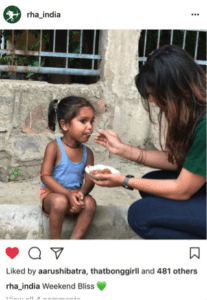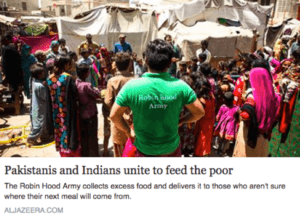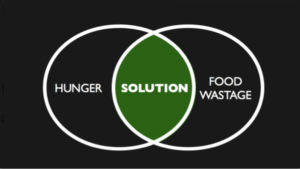Beating the Global Hunger Crisis through Digitalization

Are the government and the United Nations the only means to solve global hunger? Maybe not.
Excess Food + Community > Hunger
The Robin Hood Army is a volunteer driven organization, which collects excess food from restaurants and gives it to the less fortunate of the community across 53 cities. The team has expanded through a decentralized, hyper-local model, which serves the local neighborhood.
The volunteers are young professionals and students who contribute in their free time. The Robin Hood Army launched in Delhi, India in 2014 with a food drive serving 150 people; with a stringent no-funds policy the organization has currently served food to 4.2 million people through a network of 12,500 volunteers. The operations of each chapter are self-managed: each local unit has an Uber-esque core team which oversees basic operations, restaurant on-boarding, social media presence, and volunteer management.
The Robin Hood Army has scaled through various zero-cost modes of digitalization – reaching out to a wider audience through social media and YouTube TED talks, rigorously tracking growth metrics on Google Docs, and coordination of food drives and knowledge sharing on WhatsApp groups!
Is this the final solution?
While embracing social media and grassroot digitalization has been the binding force behind the Robin Hood Army – the impact is still barely scratching the surface of the global hunger problem. There are 794 million malnourished people in the world; conversely a third of the food produced get wasted and thrown away. The problem has never been a lack of food – but access to food.
Digitalization is the Robin Hood Army’s engine to grow its impact, but the speed of adoption can potentially come in the way of the organization making a real difference to global hunger. The Robin Hood Army has reached a phase, where it needs to transit from a project fueled by passion and energy, to a data-driven, tech-enabled platform, which can expand seamlessly.
How does the Robin Hood Army plan to grow its impact exponentially?
Over the last few months the team has launched into hyper expansion mode focusing on defined levers:
- Coordinated Social Media Strategy:.
Through a targeted strategy, which focuses on visual experiences, the social media team aims to share stories, moments, and updates across platforms to reach out to a wider audience. 92% of volunteer and press coverage requests are generated through Facebook, Twitter, and Instagram.

- Aggressive DIY Expansion into more countries:
The team has developed Do-it-Yourself kits, which guide people across the developing world to set up local Robin Hood Army chapters within their communities. There is a dedicated expansion team, which remotely helps new cities launch operations through Skype sessions. In the last 6 months, through the efforts of a focused team – the Robin Hood Army has grown it’s presence from 32 to 53 cities.
Global Hunger Spread:

- Embracing Technology:
There are three broad components to this model – the restaurants, the volunteers and the under-served. The team is at an early stage in developing technology that can connect all three players in a seamless manner to create a real-time food management solution. In the medium to long term, this is probably the most important lever to execute to actually make a significant difference to global hunger. - Mega Partnerships:
The non-funded model is a strong goodwill creator and this has enable the Robin Hood Army to carve out partnerships with global brands such as Viacom, Uber, Disney and TED.
What next?
While the team focuses on the global hunger problem, there are a couple of questions, which routinely crop up:
- With organized community platforms mobilized to help across different parts of the world, should the Robin Hood Army focus beyond food and hunger?
The team has used its resources within the community to address short-term projects on education and disaster management. With an increasingly divisive world, is this the way forward for the Robin Hood Army? - Should the team re-consider its stance on zero fund involvement?
While this policy is the basis for rapid expansion through social media without any ethical risk; this is the primary reason thousands of volunteers are attracted to the cause. However with the first principle of real impact – will the Robin Hood Army need to change this approach to develop sustainable technology to beat global hunger?
– – –
REFERENCES:
LiveMint, October 5, 2017, “The Robin Hood Army: Hunger warriors”, [http://www.livemint.com/Industry/arm2GH1zHmcZHu4BavG1dJ/The-Robin-Hood-Army-Hunger-warriors.html], accessed November 2017.
NDTV, September 17, 2017, “Robin Hood Army: Indians And Pakistanis Unite Against A Common Enemy”, [https://www.ndtv.com/india-news/a-band-of-indians-and-pakistanis-are-fighting-a-common-enemy-hunger-1751431], accessed November 2017.
Huffington Post, August 14, 2017, “The Robin Hood Army Is On A Mission To Free 1 Million People From Hunger This Independence Day”, [http://www.huffingtonpost.in/robin-hood-army/photoblog-the-robin-hood-army-is-on-a-mission-to-free-1-million_a_23076429/], accessed November 2017.
The Free Press Journal, January 1, 2017, “Robin Hood Army: Making the best from waste”, [http://www.freepressjournal.in/featured-blog/robin-hood-army-making-the-best-from-waste/995594], accessed November 2017.
Free Malaysia Today, December 16, 2016, “The Robin Hood’s who feed KL’s poor”, [http://www.freemalaysiatoday.com/category/nation/2016/12/16/the-robin-hoods-who-feed-kls-poor/%5D, accessed November 2017.
The Guardian, June 2, 2015, “The Robin Hood Army: fighting food waste in India and Pakistan”, [https://www.theguardian.com/global-development-professionals-network/2015/jun/02/the-robin-hood-army-fighting-food-waste-in-india-and-pakistan], accessed November 2017.
Robin Hood Army Website, DIY Kit, [http://robinhoodarmy.com/wp-content/uploads/sites/4/2015/07/RHA-Deck-2.pdf], accessed 2017.
TEDx, “Eat. Feed. Love.” [https://www.youtube.com/watch?v=6A1UrHirtXg&t=741s], , accessed 2017.





It’s great to see digitization adopted by a non-profit to generate growth. While using free consumer-focused platforms such as Whatsapp and Google Docs may not be sustainable in the long run. Thankfully, Robin Hood Army can adopt premium platforms that offer better capabilities for free as a non-profit. Below are two to consider.
Zapier can complete simple automation and integration steps between solutions. For example, it can be used to auto-populate a Google doc with Eventbrite registration data to share with an external team. (https://zapier.com/)
Canva is a social media and desktop publishing content generator with drag-and-drop features and professional layouts to help nonprofits easily design professional graphics and documents. Nonprofits are allowed 10 free users. (canva.com)
As the organization growths and becomes more sophisticated, there are a couple of quick wins that could be achieved through digitalization:
1-Supply planning: In the mid-term, Robin Hood Army could try to get access to its suppliers (restaurants) orders. Based on historical information, Robin Hood could predict the amount of excess food generated in a day by a specific restaurant and target a specific population size. This way the service becomes more personalized and there won’t be people in the communities that are not reached. Predicting the amount of excess food can also determine how many people is required to help serving the food, the type of transportation needed and the impact that restaurant will generate on a specific day.
2-Process standardization through digitalization: As the company expands to other countries, it will be important that general procedures or standards processes are implemented to ensure that the vision of Robin Hood Army is followed and the is no brand image at risk. To do this RH could implement a digital app used by restaurants and the benefactors in each country. Implementing this type of tools can help standardizing the process and at the same time get more data for analytics. Who can finance the App? If restaurants could have access to information such as their daily excess food supply and the amount of people they are helping nourish I think finding funds from big restaurants chains could be achievable.
While I completely understand the rationale behind zero fund involvement, I would push the RHA to consider building out some infrastructure (which will require financial investment). The organization has seen tremendous growth and appears to be at an inflection point, where it is considering expanding its scope to new causes. In order for this to go smoothly, I believe that it is a) critical that RHA can attract top talent and b) increase its investment into technology, standardization, and sophistication – both of which will be more easily accomplished by taking on funding.
Profitable social enterprises are becoming increasingly common – and while I’m not suggesting that RHA go all the way there, I believe that both investors and consumers have become more accepting of funding models that that have aligned incentives and perform. I would be very reticent to expanding too quickly without having the right people, processes, and systems in place.
I recently read an interesting study on the Nonprofit Starvation Cycle – while not all of it is directly relevant to RHA at this stage, I think it’s worth a read in this context.
http://www.macc-mn.org/Portals/1/Document-library/Research/SSIR%20Nonprofit%20starvation%20Cycle%202009.pdf
This is a great read! Though I applaud the grassroots model to address hunger and food wastage, I believe that education and disaster relief are different efforts that required a systematic and sustained presence of trained professionals that coordinate with existing regulatory bodies. Without this kind of coordination and formalization, it’s hard to standardize the experience that underserved populations are getting and to guarantee a certain level of quality. Even with its classic model, I worry about liability that RHA takes on in case something goes wrong (e.g., delivering food that is unknowingly spoiled).
With regards to a no fund model, I believe that RHA could greatly benefit from standardization and external capital as it grows. This would enable the organization to hire top talent, invest in supply chain management software, and systematically track outcomes, which in turn grows RHA’s ability to have impact.
I believe there is a huge potential for RHA to expand – not only geographically but also in terms of aid it provides. Volunteers might provide education that directly contributes to people’s elementary needs and rights, like self-defense or hygiene, but also teach them skills that might actually help them escape poverty, like English or Math. However, in order to do that in the systematic way, with needed quality and on the wide scale, RHA needs external funding, at least to empower the volunteers (give them professional training and resources needed to pass the knowledge to the ones in need). But most importantly, the organization needs continuity in leadership. Beyond the initial India team, more and more managers will be needed to supervise new markets: Those people, whose motivation and will to work for free might not equal the one of RHA’s founders, should be compensated at least to cover their costs of living to ensure they can be fully dedicated to the cause.
I would also use the external funding to build a platform for knowledge exchange and cooperation between volunteers and providers of food and other resources (e.g. hygiene products). That platform could be built in cooperation with corporate partners, using their technology and funding. For instance, I would consider partnership with Unilever to leverage their infrastructure and know-how gained on Shakti project.
RHA is a good example of reducing waste and making existing markets more efficient. It also showcases an innovative model that can be scaled / adopted in other developing markets.
I’m interested in hearing your point of view as to whether this model would work in the U.S. where food inaccessibility is prevalent due to poverty. I’m concerned that local government regulations on food safety may act as a barrier to implementation.
I’m also curious as to whether RHA will expand services to aid related issues in the area of poverty and health?